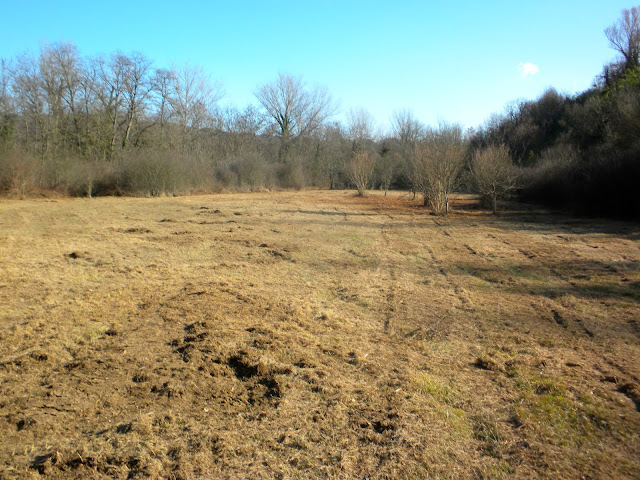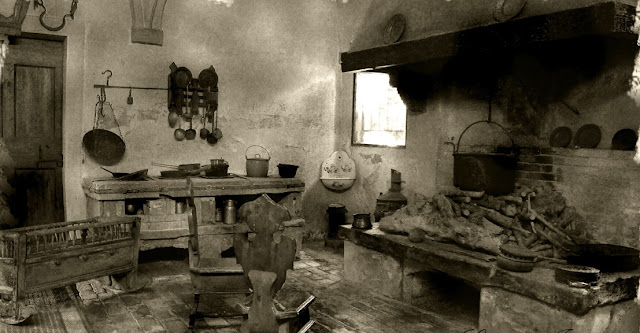il podere Le Ripe
- Le Ripe the farm -
a brief history
- Le Ripe the farm -
a brief history
 | |
| Le Ripe photographed from beside the river Pesa, July 1946 - note two haystacks, one of wheat and one probably of oats |
The old farm buildings and property called Le Ripe lie just within the Castellina commune, cheek to jowl with the Radda commune (all our neighbours are in Radda) in the province of Siena, right at the border with the province of Florence, very near Panzano in Chianti, in the commune of Greve in Chianti. Over the centuries Le Ripe and its inhabitants would inevitably have been caught up in conflicts large and small as those borders were contested, shifting back and forth.
 |
| the strada provinciale 2bis looking towards Florence province and commune of Greve in Chianti |
 |
| towards province of Siena and here, commune of Radda in Chianti |
The farmhouse, barn and concimaia or midden were most likely built several hundred years ago by tenant farmers (mezzadri) who needed to make the best use of the land allotted them: they didn't waste the flatter land on buildings, it was needed for crops.
In a reprint of an eighteenth century booklet, published to educate landowners about correct building techniques for their farms, we find indications which those who constructed Le Ripe seem to have respected.
There is a strong possibility that the original building at this location was a medieval signal or defensive tower: we have identified the cornerstones of a tower within the main farmhouse. The surrounding countryside is scattered with former medieval towers and castles: the area was fought over since Roman times at the very least.
 |
| Le Ripe's slopes |
'Le Ripe' translates as either 'the slopes' or 'the crags'. The farm's 30 hectares slope down the hill of Querceto to the Pesa river and Lucarelli, with very little space for cultivation; a real challenge to the people who settled there. Not wanting to waste the flattest areas, needed for growing wheat and oats, as mentioned above, they erected the farm buildings on a steep and rocky plot halfway up the hill. They probably spent generations terracing the slopes facing south and east below the buildings, for their grape vines, pasture and fruit trees. The broken remains of this terracing still grace the hill, hidden by the undergrowth and overarching trees.
 |
| grape harvest: note the vines growing between fruit trees, used as support: the original permaculture |
Lower in the valley, beside the river, were two meadows, one for fodder and an orchard, the other for summer corn. The rest of the wooded property, unsuitable for farming, would have furnished wood and charcoal for the fire, for cooking and warmth as well as for building, tools and equipment. A small area was planted with bamboo to provide supports for the vines: bamboo stakes filled in the rows between fruit trees, amongst which apple, cherry, plum and fig were the prime supports.
 |
| blackthorn, bamboo and bramble-infested meadow |
When we arrived these meadows were overgrown with brambles, blackthorn thickets and bamboo run amok. We have begun the slow process of clearing one meadow as well as the former road which led from the farm down to the ford at the Pesa river.
 |
| cleared campo di sotto or lower meadow where corn was grown |
 |
| cleared road leading down to Pesa and ford: the right side is still supported by a sturdy drystone wall |
At the entrance to the property hazelnut trees were raised, useful for their wood and their nuts. At Gerla, the neighbouring farm, now called Le Ripucce, walnut trees abounded until a deep frost killed all but a few, so it is possible that they were planted also at Le Ripe although only one plant survived here near the house; sadly, it had to go during the renovations. A custom common to many farms, a mulberry tree was planted to bring in extra cash from the sale of silk worms. Later we discovered several older walnuts and two mulberries, one a white mulberry, and many wild cherry trees which have become our 'cherry orchard'.
 |
| part of our wild cherry orchard: locals still speak of the original cherry tree with awe; apparently the cherries were as big as plums! |
In those days an impressively well-fashioned, ancient stone 'carrettiera/mulattiera' or mule-track led up the hill to where the house stands. This track was certainly plundered of many of its ready-cut stones, to build the farmhouse.
In the farm building itself, little space was dedicated to living: only the first floor, comprising five rooms and a kitchen with its typical cavernous fireplace which contained a bread oven, was inhabited by the farmers; the rest were working areas: the stables and byres for cows and sheep; the pigsty attached to the multi-functional 'fienile' or barn (locally known as the capanna) where hay was stored and hens, pigs and goats kept; the 'aia' or threshing-floor, made of great white flags of local stone; the store-rooms and cellars, the old stone washing trough and, last but not least, the 'concimaia' or covered manure pit.
 |
| midden (concimaia) to left, then barn (capanna) with pigsty and farmhouse with stables, byres and storage below; the haystacks were called barche di grano |
During renovations two further fireplaces were discovered on the first floor, which means that at one time there were probably three families living at Le Ripe, each with a kitchen hearth and sleeping area.
Everything revolved around making a living; every inch was used for a purpose, the materials were local stone, clay and wood with iron tools, plough, even nails made by the 'fabbro' or smith. Some equipment would have been rented and brought in during the season, such as the ubiquitous 'macchina', the 'machine', used for threshing wheat and other cereals. It was hauled up to the farm by four oxen and kept only as long as needed.
 |
| the impressive steam-driven threshing-machine, the macchina a foco which ran on wood, charcoal and sometimes straw; it would do the rounds of the farms each harvest |
Life was hard: winters were cold, summers hot, and work continued all year round. Friends have told me that even in the 60s the poorer farm houses had only straw for insulation and relied on the giant, smoking cooking hearth/fireplaces for a little warmth. Nevertheless, small signs lingered of an attention to detail which belies a purely utilitarian approach: the lilac that still grows above the trough and the daffodils which locals remember growing nearby; the curl on the wrought iron of an old lamp; the faded apricot-painted walls with their fine line of brick-red trimming.
 |
| the hearth/fireplace may have resembled this |
 |
| ..or this |
The watershed of the Second World War ended the era of the mezzadri in Tuscany: eventually most farmers left the countryside for factory jobs in the city and warmer, more convenient homes. The last country person to make use of Le Ripe was a local shepherd called Quinto (Fifth) who wintered there with his family, selling his cheeses and ricotta, before taking his flock on its long, nomadic seasonal search for pastures. Recently I learnt that he used to bring his 80 sheep up in a truck, which takes the romantic tinge off the enterprise, but they also tell me that he would roam the area on horseback.
 |
| modern shepherd and his flock |
Soon, too, Quinto's way of life became unfeasible and Le Ripe was abandoned to the sun and rain until the owner, Fiorenza Bezzi, last descendant of a long line of landowners, decided to put the property on the market. It was first sold, together with an extra three hectares of wood in another area (an addition which cropped up just in the final stages of negotiations) in 1992, but the new English owners managed only to secure the roof and carry out some initial work on the buildings, by now dilapidated and vandalized, before selling Le Ripe to us in 2005.
Below is how it was the first day we saw it in 2003.
 | |
| west side farmhouse and barn |
 |
| east side |
 |
| former kitchen with stone sink and bare remains of fireplace |
 |
| from the south |
 |
| Le Ripe September 2003: what a difference a decade makes |
Thanks owed as ever to the internet for some photos and to a book entitled Coltura Contadina in Toscana, for photo of macchina a foco.



No comments:
Post a Comment
Comments are welcome but will be checked before publishing.